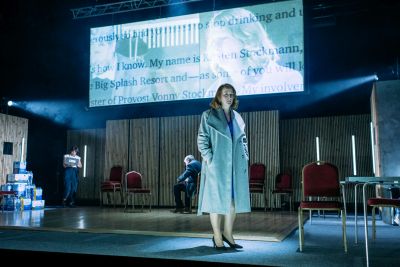The first touring production from the National Theatre of Scotland since the start of the pandemic, The Enemy is a timely and suspenseful exploration of morality, self-preservation, and corruption in today’s society.
A reimagining of Henrik Ibsen’s An Enemy of the People, Kieran Hurley’s adaptation transports the 1882 Norwegian drama to modern-day Scotland. Sisters Kirsten and Vonny Stockmann (Hannah Donaldson and Gabriel Quigley) have reinvigorated their neglected hometown by developing a health resort, in turn campaigning for the town to be named the City of Regeneration. However, when Kirsten discovers that the cutting of corners has resulted in a potentially catastrophic public health hazard, she has to face a tough decision: to do the right thing or undo all the hard work she and her politician sister have achieved. What is more, she has to convince everyone else that her choice is the right one.
Hurley has seamlessly updated Ibsen’s work for the twenty-first century. Successfully weaving in contemporary issues – including online trolling and workplace sexual harassment – Hurley adds depth to the drama while simultaneously raising the stakes. His decision to make his protagonist a single mother (originally a man in Ibsen’s original) adds vulnerability to Kirsten’s character that only intensifies the threat she and her daughter, Petra, later face.
Despite the serious circumstances at the centre of the action, Hurley’s deftly spatters humour throughout the play. A particular comedic standout is Eléna Redmond as Petra, whose unfiltered opinions are particularly entertaining. As for the rest of the cast, Hurley and director Finn den Hertog have brought together a stellar group of actors to bring this drama to life. They expertly convey the complexities of their characters, with some not revealing their true colours until the very final moments of the play. Given the play’s title, you may expect to be searching out one “enemy” among the crowd. Yet just when you think you know someone, they still manage to surprise you.
Perhaps the most impressive “character” in Hurley’s adaptation is the public – an unseen body represented only through social media comments projected above the actors. The vitriol spewed by these anonymous figures as the action progresses reflects the poisonous nature of social media. They add fuel to the fire under Kirsten, leading to a frenetic but fantastic climax.
This climax is intensified by the novel use of camera angles to focus in on Kirsten as she delivers her indictment on society. The large screen above the actors is repeatedly used to hone in on a particular aspect of a scene. Though this can be distracting – especially when the reason behind the chosen angle or focus isn’t initially clear – the payoff is often impactful.
Hurley distances himself from Ibsen in the final moments of the play. His protagonist does not have the same certainty that she can go on and prove to the people that she is right. While it would have been satisfying to see Kirsten feel some vindication, the ambiguity behind Hurley’s ending is arguably more realistic, and far more poignant. Despite a lack of closure, The Enemy is a thrilling reimagining of a timeless classic.
